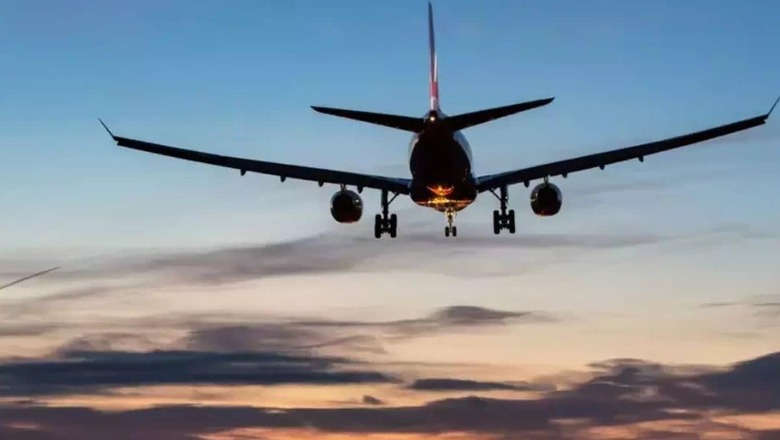
views
In recent years, there has been a concerning uptick in incidents involving civil airliners veering off course due to GNSS jamming and spoofing. These incidents highlight the vulnerabilities of our GNSS system in which the USA’s global positioning system (GPS) is at centre stage. These raise significant safety and security concerns for the aviation industry.
GNSS is a critical component of modern air travel, providing accurate location and navigation data to pilots and air traffic controllers. However, it is not immune to interference, and both intentional and unintentional disruptions can have serious consequences.
GNSS jamming is the deliberate transmission of radio frequency signals on the same frequencies used by GNSS satellites, effectively overpowering and blocking the genuine signals. This can lead to a loss of GNSS reception for aircraft in the affected area, forcing pilots to rely on alternative navigation methods or instruments. GNSS jamming devices are relatively easy to obtain and can be used by malicious actors for a variety of purposes, from criminal activities to terrorism.
On the other hand, GNSS spoofing is a more sophisticated form of interference. Instead of simply blocking the GNSS signals, spoofing involves transmitting counterfeit signals that mimic legitimate ones. This can mislead aircraft navigation systems, causing them to display incorrect information about their position, speed, and heading. Spoofing attacks can be particularly dangerous because they can deceive both pilots and air traffic controllers, leading to potentially catastrophic consequences.
Recent incidents involving GNSS jamming and spoofing have raised alarms within the aviation industry and among security experts. Here are a few notable examples
The Black Sea Incident (2017)
In 2017, a series of GNSS spoofing incidents occurred in the Black Sea region, affecting several commercial airliners and maritime vessels. These incidents raised concerns about the potential for hostile state-sponsored activities that could disrupt the navigation systems of civilian and military assets. It was believed that the Russian government was behind these attacks, which highlighted the need for improved security measures to protect GNSS signals.
Newark International Airport Incident (2020)
In 2020, a commercial airliner departing from Newark International Airport experienced a GNSS spoofing incident shortly after takeoff. The aircraft’s navigation systems began to display inaccurate data, causing confusion in the cockpit. Quick thinking by the flight crew and coordination with air traffic control allowed the aircraft to safely return to the airport. This incident highlighted the need for better training and equipment to detect and mitigate GNSS spoofing attacks.
Hong Kong Incident (2022)
In 2022, a civil airliner approaching Hong Kong International Airport experienced GNSS jamming while on final approach. The pilots lost GNSS guidance, and the air traffic control tower had to switch to radar-based navigation to guide the aircraft safely to the runway. Although the incident ended without any casualties, it emphasised the vulnerability of GPS-dependent navigation systems and the potential risks associated with such disruptions.
Global GNSS Outage (2023)
In early 2023, multiple aircraft around the world reported severe disruptions to their GNSS navigation systems. This global outage caused confusion among pilots and air traffic controllers, leading to concerns about coordinated GNSS interference on an unprecedented scale. Investigations into the incident are ongoing, but it highlighted the need for even stronger security measures and international cooperation to protect the integrity of GPS.
GNSS jamming and spoofing pose significant dangers to civil airliners, and while real-world incidents have, fortunately, not resulted in catastrophic consequences thus far, exploring hypothetical situations can underscore the potential risks and dramatic scenarios that could unfold.
Loss of Navigation
Imagine a scenario where a civil airliner on a long-haul flight encounters GNSS jamming or spoofing shortly after reaching cruising altitude. The aircraft’s GNSS navigation system suddenly goes offline, leaving the flight crew without accurate position information. In such a situation, the pilots may struggle to maintain their planned course, potentially leading to disorientation and confusion. Though onboard Inertial Reference (IR) System coupled with ABAS (Aircraft Based Augmentation System) could alert the pilot, especially if the spoofing is aggressive. Slow and effective spoofing could fool even the IR and ABAS systems.
Misleading Altitude and Heading Data
Hypothetically, consider an instance where GNSS spoofing affects an airliner’s altitude and heading data, making the onboard instruments display false information. The flight crew, unaware of the spoofing attack, might believe they are at a different altitude or heading than they are. This confusion could result in incorrect altitude adjustments, leading to a collision risk with other aircraft at the same altitude or obstacles in their path. Though all aircraft have an independent magnetic compass to check the heading, it is, however very rarely used by pilots.
Air Traffic Control breakdown
In a more dramatic scenario, GNSS spoofing simultaneously targets multiple aircraft in a busy airspace. As each airliner’s navigation system displays conflicting and incorrect information, air traffic controllers receive conflicting reports from multiple aircraft, all attempting to maintain their intended flight paths. The controllers struggle to manage the mayhem & chaos, leading to the potential for mid-air collisions or near misses or in a remote event, even a mid-air collision.
Diversion and Emergency Landings
Diversion is a real possibility due to GNSS spoofing. Off-course traffic may lead to the aircraft reaching its destination below diversion fuel or even reaching the diversion fuel enroute, forcing pilots sot put the aircraft down at the nearest aerodrome. This could lead to an emergency diversion and landing at an unplanned airport. The diversion could be prompted by false collision alerts from the spoofed GNSS data too. Passengers and crew would experience panic and confusion, and the airline would incur significant costs and delays.
National Security Threats
GNSS spoofing incidents could potentially be used as part of a broader national security threat. For example, in a tense international situation, a hostile nation might employ GNSS spoofing to disrupt the aviation sector of a rival country, creating confusion, mistrust, and potentially even diplomatic crises. To mitigate this, as part of Atmanirbar Bharat, Indian companies like Big Bang Boom Solutions (BBBS), M/s DCM Shriram Industries Ltd (DSIL) and Zen Anti Drone Systems have made comprehensive counter-drone solutions which included GNSS Spoofing and Jamming. Companies like AutoMicroUAS Aerotech and BBBS have made kinetic impact drones as well. These drones have capabilities beyond imagination, including being AI-driven in the future.
Psychological Toll on Passengers
The dramatic impact of GNSS jamming and spoofing on civil airliners extends beyond the cockpit. Passengers, unaware of the technical details, may experience fear and anxiety as they witness abnormal flight behaviour or abrupt changes in flight plans. This psychological toll can be significant and long-lasting, affecting not only the passengers on the affected flights but also the public perception of air travel safety.
While these scenarios are dramatic, they underscore the gravity of the dangers posed by GNSS jamming and spoofing to civil airliners. Aviation authorities, governments, and technology providers must remain vigilant and continue to invest in measures to detect, mitigate, and prevent such incidents to ensure the safety and security of air travel worldwide. Some of these are discussed below.
Mitigating Effects of GNSS Jamming and Spoofing on Civil Airliners
Understanding GNSS Jamming and Spoofing
Before diving into mitigation strategies, it’s essential to understand the differences between GNSS jamming and spoofing and how they affect civil airliners:
GNSS Jamming: Jamming involves the deliberate transmission of radio frequency signals on the same frequencies used by GNSS satellites. This interference overpowers and blocks genuine GNSS signals, causing a loss of GNSS reception for aircraft within the affected area. Pilots must rely on alternative navigation methods, such as inertial navigation or ground-based radio navigation aids.
GNSS Spoofing: Spoofing is a more sophisticated form of interference. Instead of blocking GNSS signals, spoofing involves transmitting counterfeit signals that mimic legitimate ones. This can mislead aircraft navigation systems, causing them to display incorrect information about their position, speed, and heading, potentially leading to erroneous flight paths.
Mitigation Strategies
To mitigate the effects of GNSS jamming and spoofing on civil airliners, a multi-faceted approach involving technology, regulation, and training is essential. Here are some key strategies:
Enhanced GNSS Security
Improving the security of the GNSS system itself is crucial. This can involve:
Signal Encryption: Implementing encryption mechanisms for GNSS signals to make it more challenging for malicious actors to jam or spoof the signals. In this regard NAVIC system of India and the ‘P’ code of the GPS of the USA are encrypted and therefore cannot be spoofed easily.
Authentication: Develop advanced authentication methods to ensure that the received GNSS signals are from legitimate satellites and not counterfeit sources.
Resilience: Enhancing the robustness of GNSS receivers to better withstand jamming and spoofing attempts, including dynamic filtering and adaptive signal processing.
Detection and Identification
Early detection and identification of GNSS interference are essential for timely response. Strategies include:
Jamming Detection: Employing jamming detection equipment on aircraft to identify the presence of interference and notify flight crews.
Spoofing Detection: Developing technologies that can recognize patterns consistent with GNSS spoofing and alert aviation authorities and pilots.
Spectrum Monitoring: Conducting regular spectrum monitoring to identify unauthorized signal sources and their locations.
Redundant Navigation Systems
To reduce dependence on GNSS and increase resilience, civil airliners should incorporate redundant navigation systems:
Inertial Navigation Systems (INS): Installing advanced INS that can provide accurate position and velocity information without external signals. These systems can act as a backup during GNSS disruptions. All airliners have this system and pilots must always correlate the position. Also, ground-based navigational equipment needs to be programmed in a manner that it’s cross-track cut and gives accurate terrestrial base navigational data. This planning is the responsibility of the Airlines.
Ground-Based Navigation Aids: As explained above, Leveraging ground-based navigation aids like VOR (VHF Omni-Directional Range) and NDB (Non-Directional Beacon) for additional navigation support
Education and Training
Proper training is essential for flight crews to respond effectively to GNSS disruptions:
Scenario-Based Training: Conduct realistic scenario-based training exercises that simulate GNSS jamming or spoofing incidents, allowing pilots to practice alternative navigation methods and decision-making.
Awareness Campaigns: Raising awareness among aviation professionals about the risks associated with GNSS interference and the importance of vigilance.
Regulatory Measures
Governments and international bodies must enact and enforce regulations to deter and penalize GNSS interference:
Legal Frameworks: Establishing clear legal frameworks with severe penalties for GNSS jamming and spoofing offences.
International Cooperation: Promoting international cooperation to address cross-border GNSS interference incidents and share information among nations.
Continuous Research and Development
The aviation industry should continually invest in research and development to stay ahead of evolving GNSS interference threats:
Advanced Anti-Spoofing Technologies: Developing advanced anti-spoofing technologies that can detect and counteract counterfeit GNSS signals.
Improved Jamming Resistance: Creating GNSS receivers with enhanced jamming resistance, capable of filtering out interfering signals effectively. AutomicroUAS Aerotech Pvt Ltd of India has developed a GNSS receiver protection circuitry that will practically block all terrestrial jamming and spoofing signals.
Multi-Constellation GNSS Receivers: Designing GNSS receivers that can access multiple satellite constellations (e.g., GPS, GLONASS, Galileo, BeiDou) to reduce vulnerability to interference.
Real-time Communication
Facilitating real-time communication between aircraft and air traffic control (ATC) is crucial:
Data Link Communication: Implementing secure data link communication systems that allow ATC to relay critical navigation information to aircraft in case of GNSS disruption.
Emergency Protocols: Establishing clear protocols for flight crews to follow in case of GNSS interference, including reporting the incident to ATC and seeking alternative guidance.
Cybersecurity Measures
Protecting onboard navigation systems from cyber threats is essential:
Firewalls and Intrusion Detection Systems: Installing robust cybersecurity measures, including firewalls and intrusion detection systems, to prevent unauthorized access to navigation systems. In this regard, a robust ABAS is a must in all civil airlines.
Regular System Updates: Ensuring that navigation system software and hardware receive regular updates to patch vulnerabilities.
Conclusion
Mitigating the effects of GNSS jamming and spoofing on civil airliners is an ongoing and multifaceted effort that requires cooperation among governments, aviation authorities, airlines, and technology providers. By implementing enhanced GNSS security, detection and identification mechanisms, redundant navigation systems, education and training, regulatory measures, continuous research and development, real-time communication, and robust cybersecurity measures, the aviation industry can significantly reduce the risks associated with GNSS interference.
It is imperative that these strategies are continually refined and adapted to address the evolving threat landscape. By doing so, the aviation industry can better ensure the safety, security, and reliability of air travel in the face of GNSS jamming and spoofing threats.
Group Capt MJ Augustine Vinod VSM (retd) tweets at @mjavinod; Vineet Maliakal is COO, AutoMicroUAS. Views expressed in the above piece are personal and solely that of the author. They do not necessarily reflect News18’s views.




















Comments
0 comment